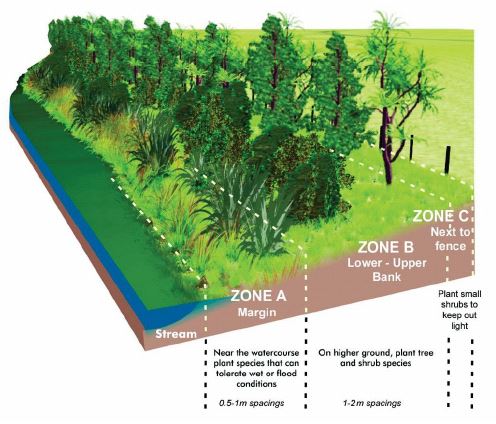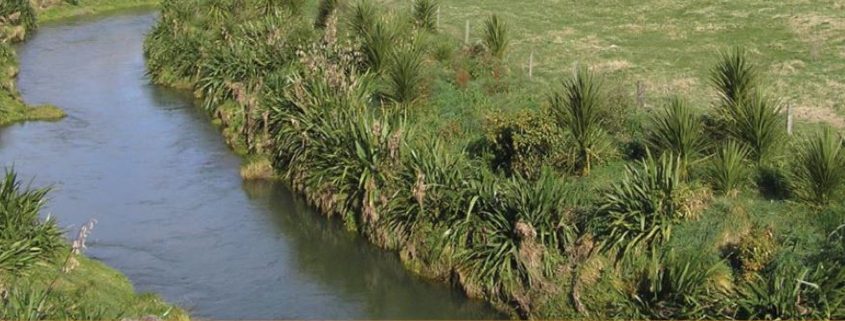Summer is a great time to start managing our waterways
Following the recent water quality woes in Havelock North, there has been a wider interest across communities around the way that we manage our waterways and it has been no surprise that we have seen the finger pointed at farmers for sediment, bacteria and nutrient run-off or images of stock standing in streams and rivers. As many waterways run through farm land and the opportunity for animal faeces to enter our waterways is high, this is one area where feelings run high and the wider community look long and hard at our tourism claims of 100% Pure. Even the National Party has promised to ban dairy cattle from waterways, by pledging to spend $100 million over 10 years to buy farmland next to sensitive waterways to use as an environmental shield to protect water quality.
With many farmers already taking a proactive stance on fencing off waterways, the challenge now is to take that next step and actually start to manage the Riparian areas, or waterway margins, which are the strips of land that run alongside waterways. If you have any waterways on your land, managing your riparian areas is something to consider. It may take a bit of work up front, but it can have benefits for your land, your livestock, and for the surrounding area’s environment. Also farmers can now deduct the expense of riparian planting as an operational expense.
Why you should manage your waterway margins
Managing riparian areas will
1. Prevent livestock from entering the waterways and contaminating the water
2. Reduce erosion – both natural erosion, and erosion from livestock trampling the area
3. Prevent stock losses and nutrient runoff
The benefits of planting
• When planted right, the plants roots will help prevent erosion
• Some plants can provide extra fodder for livestock
• Water quality will improve as plants filter pollutants and control flood flows
• Planting will provide habitats for wildlife
Managing your riparian areas
Management can essentially be divided into two areas – fencing and planting. These two management techniques work best when used together, especially if you keep livestock near the area, but can be used individually.
Assessing your riparian areas
You’ll need to identify your waterway’s water levels to fence or plant the area. Take note of:
• The stream edge
• Wetlands
• Any slopes and their steepness
• Where regular flood levels lie
• Where annual flood levels lie
• Any extreme flood levels

Fencing riparian areas
Depending on what you use the surrounding land for, and your budget, fencing your riparian areas may be the cheapest and simplest option. Fencing should always be considered if you keep livestock near your waterways. If you have temporary livestock in surrounding paddocks, you may only need a temporary electric fence to block off the riparian areas. You can adjust your fencing to suit the season, moving it to suit flooding. If livestock will be permanently in paddocks surrounding the riparian area, you will need to place the fence five metres from the flood zone, unless you are prepared to move it regularly.
Fencing is a good minimum option for those with livestock who have a low budget. It will prevent livestock from contaminating the waterways and will prevent them eroding stream banks. However, without planting, it will not completely prevent runoff, slow flood flows, or reduce natural erosion. Native planting has advantages of shading and cooling streams, reducing weed invasion, and once established there is little long term maintenance work.
Planting riparian areas
If you do not have livestock near your waterways, riparian areas still need taking care of, particularly if you have crops nearby as nutrient runoff can pollute the waterways. Regardless, planting will help control the waterway’s flood area, prevent natural erosion, and will improve water quality – which is important, even if you just want to allow your kids to go for a swim in the river.
The planting width of riparian areas should vary with the landscape, but a width of at least 5 metres will bring additional benefits. A planting plan should be created to allow for how much space individual plants require. When planting, consider the time of year. You’ll want to plant them so they have time to establish before the dry summer comes around, but any frost sensitive species will need to be planted in early spring.
Plant types need to be divided up into areas you took note of during your assessment of the riparian area.
Maintaining riparian areas
Once your plants are in, you’ll need to keep an eye on their health, and weed as required. Check fences and ensure they are maintained too, and if you have any fodder trees, make sure their growth does not affect the fence lines. If any plants do not take to the area, make sure you replace them. Pest control may also be necessary.

Help Is Available
The Hawke’s Bay Regional Council have a team of Land Management Advisors who are keen to work with farmers to assist them in protecting the waterways and enhancing the farm values through riparian planting, fencing and land management strategies. Their team has an extensive and diverse range of skills in the sustainable management of land and work closely with landholders, community groups, industry and government agencies to promote the use of appropriate land management practices.
Not only can they assist with the plan development aspects of this, but they have a riparian plant scheme to provide appropriate plants and administer HBRC’s Regional Landcare Scheme. That is a contestable fund that can provide financial grant assistance for erosion control and protection works (planting, retirements and structures) and biodiversity protection of bush, on farm wetland and stream retirements through covenanting.
To find out more about how they can help, we suggest that you contact Erica Smith or another Land Management Advisor at HBRC on phone: 0800 108 838, mobile: 027 311 1050, or email: erica.smith@hbrc.govt.nz
Finally, central Government have been quite clear that they are taking a real interest in waterways management, and have signalled on more than one occasion that they may drive a quicker change process that the 2020 stock exclusion policies in the Tukituki catchment and which are likely to be proposed by Councils in future catchment plans. Some commentators have suggested that this could come into force by late 2017, so now is the time to consider the implications of this on your farm practices and plan accordingly.



